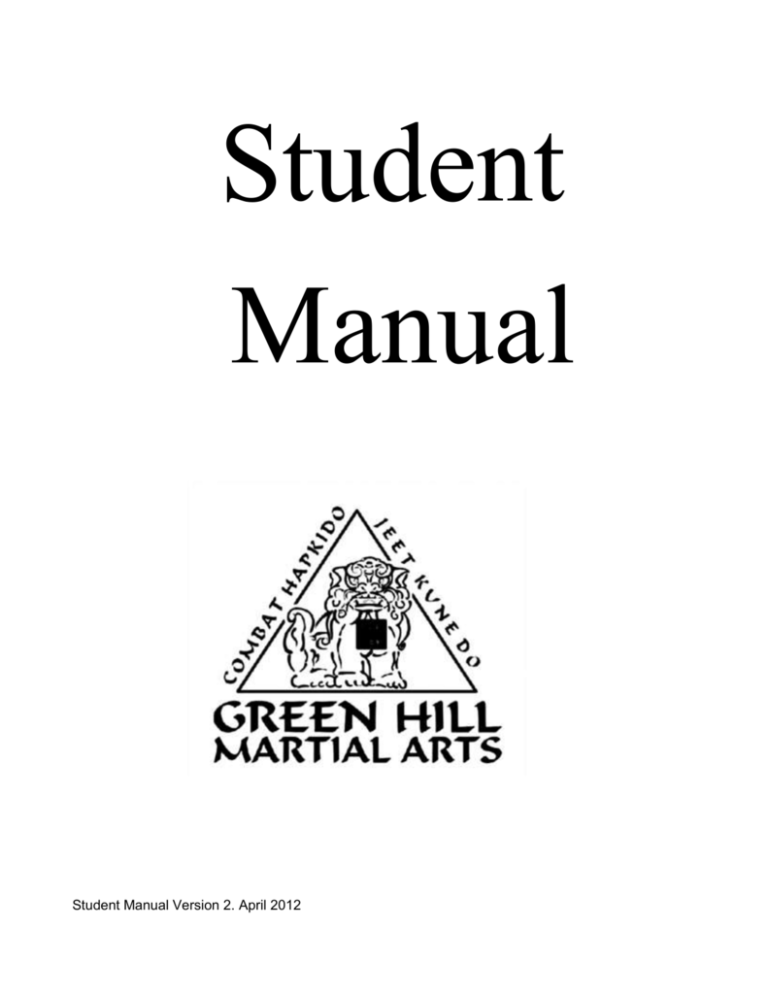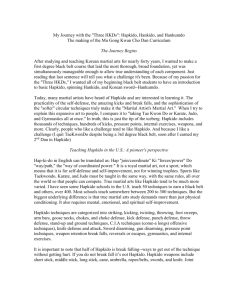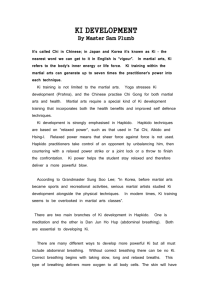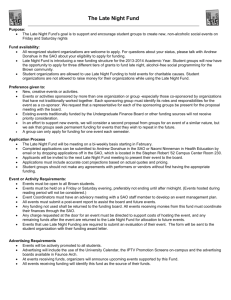Student_Manual - Green Hill Martial Arts
advertisement

Student Manual Student Manual Version 2. April 2012 Green Hill Martial Arts offers training in two martial art forms: Combat Hapkido/Chon Tu Kwan and Jun Fan Gung Fu/Jeet Kune Do. Students are free to concentrate on one, or both disciplines. Each alone is designed to provide a range of skills needed for self- defense. However, while each art offers diverse skill sets and come from different backgrounds, we have found that they greatly complement one another. A student will not have to unlearn one skill set to apply a different if he/she chooses to study the other art. History of Chon-Tu Kwan (Combat) Hapkido Combat Hapkido (known in Korean as Chon-Tu Kwan Hapkido) is a martial arts system developed by Grand Master John Pellegrini over the course of many years. In 1992 he formed the International Combat Hapkido Federation (ICHF) the governing body of Combat Hapkido. In 1999 the ICHF was recognized by the Korea Kido Association and the World Kido Federation, also known as the Kido Hae, as the Hapkido style Chon-Tu Kwan Hapkido. The World Kido Federation is recognized by the Korean Government as the organization that bridges Korean martial arts with the rest of the world’s martial arts community. Grandmaster Pellegrini created Combat Hapkido to utilize more scientific principles and modern concepts of self defense. Combat Hapkido has been called the "Science of Self-Defense" and is an application based upon key Hapkido techniques. The word "combat" was selected to differentiate the style from more traditional Hapkido styles and to denote its focus on self-defense. Combat Hapkido utilizes joint locks, throws, pressure points, and primarily low line kicks to train students to counter or preemptively strike an imminent attack and/or disrupt various types of attacks. As with most Hapkido styles, Combat Hapkido emphasizes circular motion, non-resisting movements, and control of an opponent through force redirection. In fact, the term Hap-ki-do refers to the way of combining one’s energy with an opponent’s in order to defend against attack. Students also employ footwork, distracting strikes, trapping, and certain body positions to gain advantage against opponents. In a constant pursuit to improve the style, Combat Hapkido discards extraneous movements and techniques and borrows from other arts only those features considered most effective. In this way Combat Hapkido incorporates elements of Jeet Kune Do, Jujitsu, boxing, wrestling, and other forms in order to give students a full breadth of defensive training that is unparalleled by other systems of defense. History of Jun Fan Gung Fu/Jeet Kune Do (JKD) Let's start by breaking down the name. Jun Fan is the Chinese name of legendary martial artist Bruce Lee. Gung Fu (specifically Wing Chun) is the art he practiced in China, and then the United States. Jeet Kune Do translates to "Way of the Intercepting Fist". Over the years, Bruce Lee's Gung Fu evolved. He dumped what didn't work and added techniques and concepts that did, such as those found in Western boxing and fencing. This new art, which he named Jeet Kune Do, incorporated the practice of attacking while defending - hence the "intercepting fist" Bruce Lee's student, Guru Dan Inosanto continues the journey of his late teacher. It reaches our school through one of his students - Sifu Raffi Derderian. In JKD we defend/attack with our strong side forward, unlike the stance taken in traditional boxing. This puts our strongest, quickest weapons (arms and legs) between us and our opponent. Striking and kicking play a very strong role, but added to our arsenal is a variety of highly effective traps and locks. There is a balance and flow to our foot and handwork, which is put to the test in light (safe!) sparring sessions. While there are no belts awarded in this art (at least in our particular system), students advance through levels. Level 10 earns a black sash, the equivalent of a black belt. Club Rules Introduction The purpose of this guide is not to replace the instruction provided by your teachers at Green Hill Martial Arts, but rather to provide all members with a common understanding of the basic concepts. Having the proper decorum and conduct by members of our club is imperative to create and maintain an atmosphere of mutual respect for students and teachers alike. Though the study of martial arts is a highly individualized experience, the instructors of Green Hill Martial Arts recognize that success is also a group effort and together we can collectively contribute to each other’s growth and development. The following rules of conduct were designed in an effort to foster an atmosphere where each person can achieve their goals in the martial arts. Punctuality Students must be on time for class. We understand that occasionally conditions beyond the student’s control may result in arriving late. When arriving after the class has started, students should wait off the practice floor for the teacher to acknowledge the student and welcome him/her to class. Likewise, if a student needs to leave before the scheduled end-time of the class he/she should notify the instructor prior to the start of class. Students who are sick/have a cold should not come to class. Children must be picked up promptly at the end of class. Parents are asked to arrive five minutes before the end of class. Entering/Leaving the Practice Floor It is a long-standing tradition in most martial arts for all participants to show respect for the training hall by bowing when entering and leaving the practice floor. Green Hill Martial Arts abides by this tradition and all club members must bow when entering and leaving the floor. During class if a student finds it necessary to leave the practice floor (such as to use the bathroom or get water) he/she should ask permission of the teacher beforehand. Leaving the floor during class can be disruptive to other students and every effort to minimize the need to be excused during class should be taken. Mutual Respect Club members should treat every other member with respect. Green Hill Martial Arts is family club and there is no situation where anger, disrespectful conduct, or dangerous behavior will be tolerated. Repeat problems in this area will lead to expulsion from the club. In the event that any interpersonal issues arise between students, the matter should be brought to the attention of a teacher privately. Attire Proper attire is important to maintaining a consistent image and feeling of unity. We believe in providing club members with a certain degree of latitude with regard to how they dress for training while achieving our goal of taking pride in our club. All clothing should be clean and in good condition (no rips, etc). Students are expected to place their shoes and other apparel in designated areas of the anteroom, shoes should be placed neatly. Footwear: Students may choose between training barefoot or wearing wrestling or martial arts style sport shoes. If shoes are worn they must be dedicated to indoor use to keep the practice floor clean. JKD students are encouraged to wear sneakers or wrestling-type shoes, again, dedicated exclusively to indoor use. Clothing: Green Hill Martial Arts shirts are mandatory but students who possess legacy gear from the Green Hill Combat Hapkido school may wear those shirts and/or pants if they choose on an interim basis for regular work-outs. However, Green Hill Martial Arts shirts will be mandatory for testing. Jeet Kune Do (JKD) attire is appropriate for JKD classes. Pants must be of martial arts style and be either black or white (if you have questions consult with your instructor). Shorts are also acceptable as long as they are consistent with these guidelines (all black or all white) and do not have buckles, zippers, or other metal that could injure other students. Students may not wear watches or other jewelry that could cause accidental injury, scratching, etc. Instructors at black belt or higher level may choose their own uniform combination, including, if desired, a traditional martial arts uniform (gi). Students from red belt candidate and up must have a gi available as many techniques require it. An acceptable gi color is white, though students at black belt level may choose black. Attention Students should maintain a focused concentration on all aspects of instruction for the duration of the class. This may take practice but it is an important skill that has benefits in all aspects of life. Maintaining attention means that students should minimize any conversation during class, though simple communication between students necessary for effective training (such as holding a striking bag at a different position) and encouragement are allowed. Appropriate posture is conducive to reinforcing active listening skills by students. The following rules are designed to reinforce proper decorum. Students at attention during class should have their arms at their side or behind their back. It is not appropriate to stand with your hands on your hips or with your arms crossed. When students are instructed to sit they should do so with their legs crossed and arms in their lap unfolded or on their knees with their back vertically straight. It is not appropriate to lounge on the floor. Unless told otherwise, it is inappropriate to lean against the walls in the training area. Guests/Spectators Parents and others who are not participating in class and wish to stay at the school during the session may wait in the studio’s anteroom. Under no circumstances are non-participants allowed to comment or converse with students during classes. Parents who hold rank of first dan and above, as well as other students who are at any instructor level may be on the floor during classes with the approval of the instructor in charge. Prospective students who would like to take a free class must make arrangements with an instructor and have his/her permission. Terms of Address/Vocabulary The following is a basic list of terms used commonly in the club. Children, for example, should address Combat Hapkido teachers as “Mr/Mrs/Miss” in the event the student does not know the Korean term for teacher (Sonseang-nim). Other basic Hapkido terms: Dojang (our practice facility/studio) Dobok or bok (uniform, gi) De (belt) Hakseang (student) Yudanja-nim (black belt holder) Sonseang-nim (teacher) A more complete listing of vocabulary terms is listed at the back of this manual. Study Beyond Green Hill Martial Arts The study of martial arts can be a life-long pursuit and students can benefit greatly from cross-training in other arts. To glean the most out of Combat Hapkido, each student is expected to have access to a copy of Grand Master Pellegrini’s Combat Hapkido book for reference and home study. JKD students would be well-served to read Bruce Lee’s Tao of Jeet Kune Do and The Ultimate Guide to Jeet Kune Do. Other related books are useful and students should ask the instructors about these references as they will likely have familiarity with them. Club Dues/Tuition Green Hill Martial Arts is a club and as such it is expected that members will support the club in various ways beyond the nominal tuition. For example, keeping the club clean is the responsibility of all – it is our club and we should be proud of it inside and out. Monthly tuition will be paid the first week of every month by personal check. It is expected that once a student has chosen his/her plan of attendance they will pay for their full month’s dues regardless of the actual number of classes they attend that month. In cases where a student knows they will be out of class for an extended period of time he/she should speak with an instructor to determine if alternate arrangements can be made. Fees for tuition and belt testing will be posted/communicated in the club. Chung So Nyun (Youth Hapkido) This program is designed for students up to age 12. Upon completing all requirements, as well as other prerequisites as directed by the club’s instructors, the student will be awarded a black belt (1st poom) in Chung So Nyun Hapkido. The time it takes to complete this curriculum will vary from student to student, and while knowledge of techniques is clearly required, a student’s behavior and participation in and out of class is also a primary determinant of testing at all levels, especially for youth black belt. As example, the first three students to achieve Chung So Nyun black belt in Green Hill Martial Arts spent several years of study before reaching this rank. Chung So Nyun removes some of the more complex and dangerous techniques from the system while retaining a fully effective program of self-defense for young students. It also introduces some of the elements of other martial arts systems such as Karate, Judo, Kung Fu, and other martial arts, while retaining a primary focus on Combat Hapkido. At age of 15 or older black belts in Chung So Nyun may test for their adult Combat Hapkido black belt rank once the instructors feel the student is ready. Rank System/Promotions Combat Hapkido uses a ten belt rank system with the complexity and number of techniques increasing with each belt. All rank certification is done directly through the ICHF Headquarters and is kept on file to ensure that each student meets the proper time in grade requirements. Higher dan grade black belt students are strongly encouraged to appear before Grandmaster Pellegrini at one of the many seminars held around the country. However, students of all levels are welcome to attend these events. JKD students do not receive belts, but advance up ten levels to black sash. Testing is cumulative, each level requiring the display of knowledge of the previous levels. Promotion is conveyed by Sifu Raffi Derderian of Derderian Academy of Martial Arts. Students will be informed when they should test for promotion. It is inappropriate for students to question instructors about when they will be ready to test for their next rank. Promotion to the next belt requires knowledge of the material as well as appropriate behavior in and outside the club. Appendix 1 Vocabulary List BASIC KOREAN TERMINOLOGY OPEN AND CLOSE OF CLASS Charyut Kuki aye Kyung yet Baro Sabom-nim aye Kyung yet Attention Face the national flags Salute (hand over the heart to the flags) Return Face the instructor Salute (bow to instructor) FORMS TRAINING Joon bi Ready Shee jak Begin OTHER TERMS Do jang Training Hall Dobok Uniform Dee Belt Gup Grade (for white and colored belts) Dan Black belt ranks (one through ten) Suseung-nim Term of address for instructor – used by a student to address instructor Hakseang Student Hapkido-in Student who studies Hapkido Yudanja-niim Black belt holder Basic Chinese (JKD) Terminology Bai Jong - Ready Position Biu Gee - Thrusting Fingers Biu Sao - Thrusting Hand (often used as a block) Boang Sao - Deflecting Hand (Raised Elbow) Chi – Energy Chi Sao - Energy Hands (AKA “sticky hands”) Chop Choi – Extended Knuckle Strike Chung Choi - Vertical Fist Cup Sao - Scooping Hand Da – Hit/strike Do – “Way” (AKA “Tao”) Dum Tek - Stomp Kick Fon Sao - Trapping Hands Fook Sao - Horizontal Deflecting Hand Gon Sao - Outside Wrist Block Gua Choi - Back Fist Gua Tek - Inverted Hook Kick Gum Sao - Pinning Hand Hay - Begin Hou Tek - Back Kick Huen Sao - Circling Hand Jang - Elbow Jao Sao - Running Hand Jeet – Stop/intercept Jeet Gurk - Shin Block Jeet Kune Do - Way of the Intercepting Fist Jeet Tek - Intercepting Kick Jern – Vertical Palm strike Jik Chung Choi - Straight Blast Jik Tek – Straight or Front Kick With Toe Jin Choi - Uppercut Jong Sao - Dummy Hand Juk Tek - Side Kick Jung Da - Middle Hit Jut Sao - Jerking Hand Kune - Fist Kwoon – School Lao Sing Choi - Lateral Hammer Fist Strike Lee Jun Fan - Bruce Lee's Chinese Name Lin Sil Die Dar - Defend while hitting Lok Sao - Rolling Hands Lop Sao - Pulling Hand Maun Choi – Lead Jab Maun Sao - Front, Inquisitive/asking hand Mook Jong - Wing Chung Dummy Na – Locking/submission O'ou Choi - Hook Punch O'ou (Now) Tek –Hook Kick (AKA Round House Kick) Pak Sao - Slapping Hand Ping Choi - Horizontal Fist Saat Da – Knee Strike Si Bak - Your Instructor's Senior Si Fu - Teacher or Instructor Si Gung - Your Instructor's Instructor Si Hing - Your Senior Si Jo - Founder of the System Si Sook - Your Instructor's Junior So Tek - Heel Kick Sut Sao – Slicing/chopping hand Tahn Sao - Palm Up Deflecting Hand Tek - Kick Tow Dai - Student Wong Pak – Outside Cross Slap Wu Choi – Cross Strike Wu Sao – Rear/Protecting Hand Yu Bay - Ready






